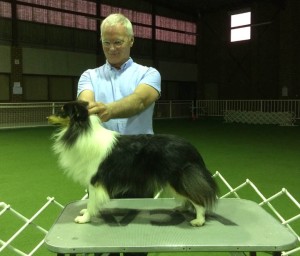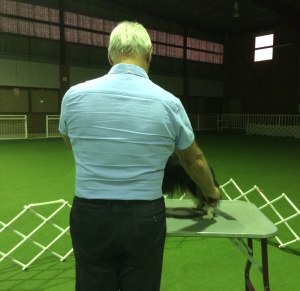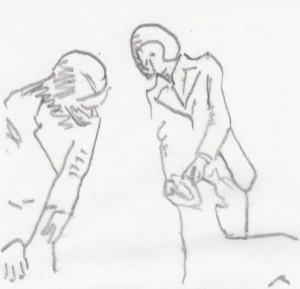Around the world, the numbers of dogs being exhibited at All Breeds shows has declined. For some breeds, the classes are becoming so small that many classes now have only one exhibitor. The result of this is that many judges use this development as an opportunity to speed up their judging by allocating a lone exhibitor less judging time than those in multiple entry classes.
One common instance of this can be observed when the judge allows little or no time for you to stack your dog for conformation inspection before they immediately begin their examination. In a class with multiple entrants, the dogs are usually run around once and, when they come to a halt, the judge positions themselves to view the dogs’ side profile in order to gain an overall impression of the class. Once the judge has a mental image of the exhibits, they will then proceed to the first exhibit to physically examine each dog’s conformation.
This procedure allows the first handler valuable seconds to prepare their charge for the confirmation examination that is coming. Obviously, the other exhibits gain even more preparation time for this but the normal judging approach still allows the first exhibitor enough time to present their dog without being too rushed. In most cases, a sole exhibitor is not afforded this same luxury but there is something that you, the handler, can do to gain enough precious seconds to settle and prepare your dog.
You can outfox the fox.
Outfoxing the fox means thinking outside the square, not following the cows’ path and handling to suit you and your dog – not simply a judge in a hurry.
With tabled dogs, if you’re the only exhibitor and you’re asked to run around once then straight to the table, break from tradition and set your dog up on the table (to the front and judges side) and position yourself between your dog and the judge.
Remember, to achieve the perfect stack you need to remain calm. This means not rushing but making sure that all your movements happen in slow motion. Only move the legs you have to move. Feeling under pressure, some handlers will automatically pick up both legs (either front or back) when, most probably, one leg or even both were already in the correct position. So, take a deep breath and look before you act. It may take some practice, but if you perfect the techniques that I’ve been writing about, you should be ready for the judge in no more than three to four seconds.

Ready for the Judge. It is so easy and quick. Note: right hand fingers not obvious, left hand in a yoke format and arms fully extended & express your pride.
Once you’re satisfied that your dog is ready for inspection, slowly and smoothly move around the table to your dog’s non-show side. Next, extend your arms proudly to communicate to the judge via body language that, “My dog is now ready for your inspection sir/madam”.
With on the ground judging, a different technique needs to be employed. For the ‘on you in a second’ judge, you’ll still need those valuable few seconds to set-up your dog but a traditional full stack is not always necessary. Unlike the handler of table-judged breeds, the ground handler has a different type of control.
In this situation, if you are a sole exhibitor, before you enter the ring, take time to observe where the judge is standing. Doing this means that when you’re asked by the steward to either run directly towards the judge or to run around to the judge, you can come to a halt about three metres (three yards) before them. This action will now require the judge to make a few steps towards your dog before commencing their examination, which means you now have a few extra valuable seconds to correctly stack your dog.
This technique will also mean that you can present your dog front-on to the judge. This makes the position of your dog’s rear legs and tail less important than their front, which not only saves you time, it also means that you’re ready to present your dog’s teeth head and teeth. Likewise, not wasting time on stacking your dog’s rear gives you more time to bring your dog’s attention back to you – the handler – and not the approaching stranger i.e. the judge.
These techniques are not about showing disrespect to judges but to ensure that the dog you handle obtains the equal attention – and chances of winning – as dogs that are in multiple-entry classes do.



As the owner of a breed where it is not uncommon to have the only breed entry, thank you for this. It is most useful.
Tracy, when you apply this technique with skill and smoothness it works every time, the worst thing we handler’s do is rush and even worst is being rushed. When I illustrate to the judge the dog is now ready for inspection, with body language try to indicate this way of presentation was no dis-respect to the judge at all. Good luck with it, it works 10 out of 10 for me.
I have often thought of doing this, but thought it might appear rude. thank you for your article as now I have the confidence to give it a go!! :0)
Dawn, I do not believe it is rude to present to the judge your dog in the best light possible. If this technique is applied smoothly and with skill and almost in slow motion and when finished with body language proudly indicate to the judge the dog is at it’s best and ready for their inspection it cannot be construed as rude on you part. There are no rules regarding this procedure just common courtesy on our (handler’s) behalf. Good luck with it, would be pleased to know how you get on.
Thank you! I am returning to dog showing after a 20 yr absence, and with a breed that is new to me (SFT). And as noted in your article, I will be the only dog in the breed all three days…with a senior puppy male. Good tips! And now some deep breaths for the nervous handler. 🙂
Fiona, love SFT’s they do not need as long to stack as some breeds, so if you apply this technique what ever you do “do not rush” fight the nerves and carry out the action required smoothly. There are no rules applying to this method, just common courtesy on our (handler’s) behalf, so show your dog proudly and have fun, leave your nerves at the gate and just totally concentrate on what you have to do.
Good luck, love to know how you get on.
Thanks Peter, a very informative and helpful article, I look forward to trying this technique out.
Hi Christine, pleased you found this blog informative, used properly it works every time. Best Peter.
Oh and my senior puppy male, went Group 1 and BPIS! The second day however, he turned his head and took the judge’s arm in his mouth as she went to go over him on the table…no pressure, just held it there, wagging his tail.I think he was saying “Ma’am, you don’t know me well enough to be touching me like that.” She was a terrier judge, but I will never forget the look on her face…and again when I said, “Reilly, Out”. and he politely removed his mouth from her arm. ..( My background is in working dogs and the former Schutzhund sport.) I wanted to die and slink under the ground I was so utterly mortified. She didnt write us up….but that was Reilly’s last day in the conformation ring. Little beggar! He has gone on to be equally as entertaining in the sport rings…like the time he wandered off with the bowl of weiners that was supposed to be a distraction, not his breakfast. Life with terriers! But you know, I wouldn’t have it any other way. They sure keep one humble.